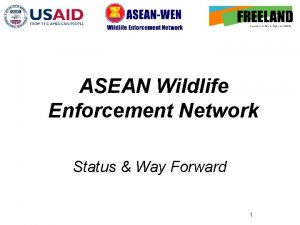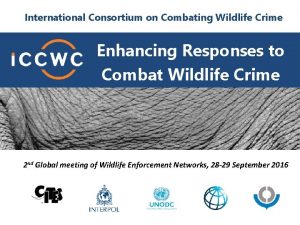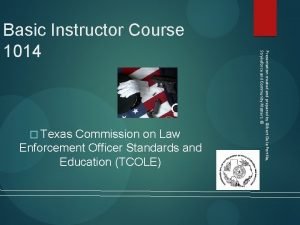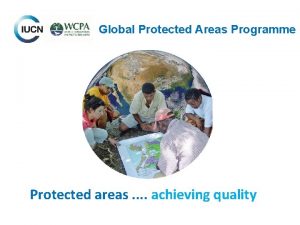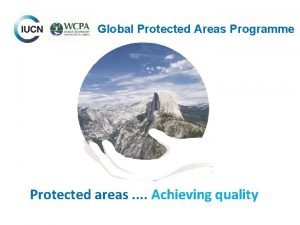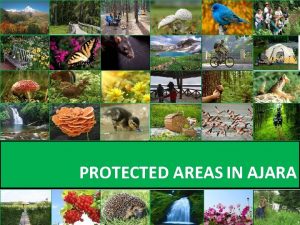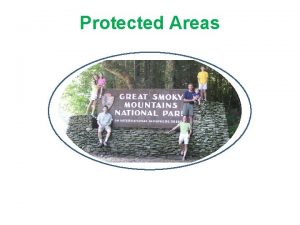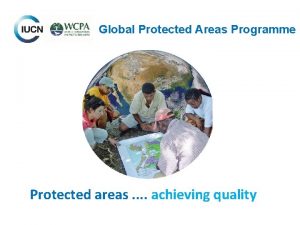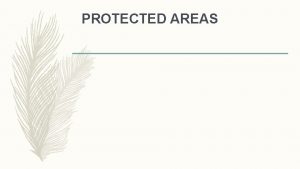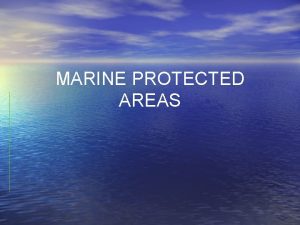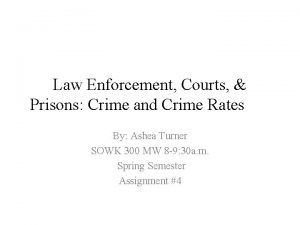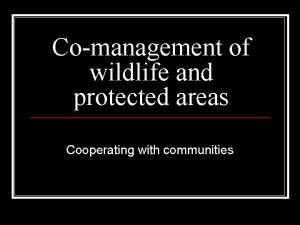Wildlife crime and law enforcement in protected areas















- Slides: 15

Wildlife crime and law enforcement in protected areas: introduction ELIZABETH L. BENNETT ▪ WORLD PARKS CONGRESS 2014

The issue High-value species are being killed inside protected areas, not just outside them. E. g. , 2009 -2013, Selous Wildlife Reserve, Tanzania, lost 66% of its

Last year, 1, 004 rhinos were killed in Kruger National Park, South

Sumatran and Javan rhinos are now extinct across mainland Southeast Asia, including from inside all protected areas.

In India, tigers became extinct from Sariska and Panna Wildlife Reserves, although small populations are starting to re-establish following reintroductions.

A similar picture exists for many smaller species, e. g. , Burmese star tortoises were hunted to extinction in the wild, including in protected areas. This overview focuses on terrestrial species, but the same is occurring for marine. E. g. , illegal fishing of sharks inside the Galápagos Marine Reserve. These losses are mainly due to illegal harvesting for international trade.

Implications In addition to loss of charismatic species, such losses have wider implications. E. g. , African forest elephants disperse seeds of > 96 species, and create and maintain mineral-rich clearings important to many species.

Such losses also damage livelihoods. In Kenya, wildlife tourism generates 12% of GDP, and supports ~300, 000 jobs.

Security of local communities living in and around protected areas is also threatened by the armed poaching gangs.

On the positive side, protected areas are the last, vital refuges for species affected by wildlife trafficking. Proportion of range and total population in Protected Areas Species Range Area Range in PAs % range in PAs % total popn in (km 2) Tiger (km 2) PAs 1, 111, 101 219, 649 20% 73 -83% Asian elephant 926, 776 186, 339 20% 65 -85% Gaur 778, 526 147, 250 19% 65 -85% Banteng 190, 933 106, 180 56% 85 -95% 5, 384 5, 200 97% >98% Sumatran rhinoceros 25, 205 24, 650 98% >98% Javan rhinoceros 996 100% Greater onehorned rhino

For PAs to play this role, longterm, hands-on management, including enforcement, is needed. This can be done by governments, local communities, NGOs, private sector, or some combination according to what’s locally appropriate.

With such management, including SMART patrols, parks are very effective at conserving high value species, e. g. , elephant densities in Nouabale. Ndoki NP, Congo, compared to surrounding logging concessions.

Given the high value of certain species, a challenge is securing sufficient funding for such protection. E. g. , effective tiger conservation costs ~$930/km 2/year. Current spending is ~$500/km 2/year.

Support is needed at all levels, from local communities, civil society and governments, if high-value species are to be conserved, playing their full ecological role in protected areas, and re-expanding from those source areas across the wider landscape. These two sessions give diverse examples of this, available tools and standards, and discussions on next steps needed.

Thank You. Learn more about WCS and the World Parks Congress. wpc. wcs. org ebennett@wcs. org
 Asean wildlife enforcement network
Asean wildlife enforcement network Wildlife adalah
Wildlife adalah Law enforcement mental health and wellness act
Law enforcement mental health and wellness act Military and law enforcement
Military and law enforcement Military and law enforcement
Military and law enforcement Law enforcement video association
Law enforcement video association Texas commission on law enforcement
Texas commission on law enforcement Night vision lease program
Night vision lease program Leads provides access to
Leads provides access to Law enforcement information exchange
Law enforcement information exchange Valeap
Valeap Nllea
Nllea Law enforcement information exchange
Law enforcement information exchange Elvis law enforcement database
Elvis law enforcement database Law enforcement agencies
Law enforcement agencies Law enforcement first responder
Law enforcement first responder
